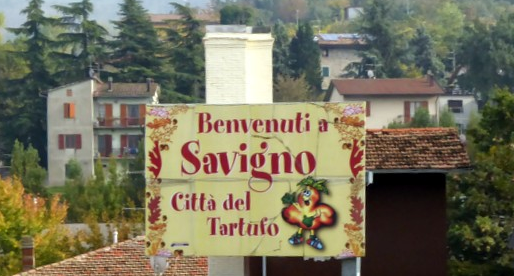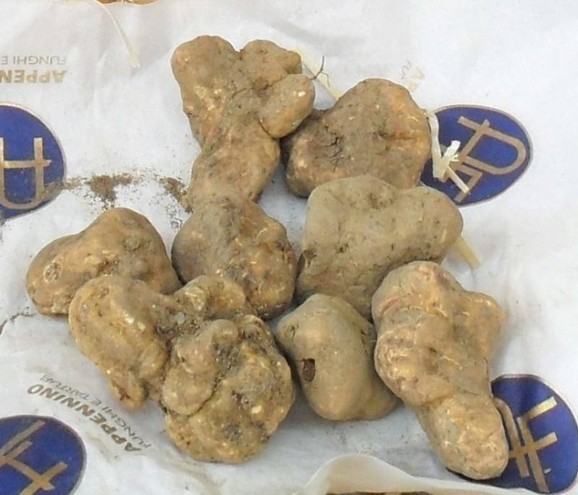Truffle Hunting in Italy
In the rolling hills of Emilia Romagna just south of Bologna is the small town of Savigno, the self styled city of the truffle. Located in an impossibly beautiful landscape of rolling hills, woodlands and green pastures, the principle activity here is farming. More recently truffle hunting has become the dominant activity. Demand for the ‘diamond of the kitchen’ as the white truffle is sometimes known is growing exponentially. Restaurants in New York, Los Angeles, Shanghai and Sydney compete to acquire the finest truffles for use in a huge array of recipes. In late 2016 the price for a kilo (about 2lbs) of white truffle exceeded € 2000–. Savigno is sitting on a gold mine…
I arrived in Savigno with a group of tourists from China and Hong Kong. We were in the middle of a ‘Gastronomy and Wine’ tour of Northern Italy. In an action packed day we had started at a cheese-maker in Reggio Emilia, before first light, where we watched the production of Parmesan Cheese. After the purchase of numerous pieces of Parmigiano and a selection of Parma hams that the gift shop had shrewdly put on display, we speeded eastwards to the hills of Emilia Romagna in search of truffles.
The amazing and delightful thing about truffles is that they grow naturally in woodland areas. So in theory anyone can find them, even the casual walker out in the countryside for a gentle stroll. Typically they are found growing close to tree roots, especially the roots of oak trees. In the old days local people used pigs to discover the truffles using their keen sense of smell. Rather unfortunately the pigs developed a taste for the aromatic and pungent truffles and it became difficult for the hunters to snatch these precious culinary jewels from the jaws of the porcine forager. Prudently, hunters switched to dogs to find the truffles, still with a finely tuned sense of smell and a much more consistent ability to follow instructions.


It was a beautiful day, ideal for a walk in the hills. The early morning fog, so common in this area in the autumn had disappeared as the sun rose in the sky. The sun shone brightly and the sky was a magical, celestial blue colour. Locals say that if it is a good year for the vines then it is not so good for truffles. Conversely if it is a poor year for vines, in other words too rainy, then it is perfect for truffles. We parked in the town square and awaited our ‘truffle hunter’ and his dog. Franco Donati didn’t keep us waiting long. He arrived in a mud-covered land rover and beckoned for our driver to follow him along a narrow road that climbed steeply up the hillside. We drove for about 3 miles before pulling over at the side of the road. There was a lot of messing about as the eager visitors donned wellington boots and anoraks ready for their ‘truffle hunting’ expedition.
Franco released his truffle hunting dog from the back of the car and marched into the woods. It was clear that we should follow. I scurried along behind Franco and asked him about his dog. He explained that he had four hunting dogs at home and this one, today’s dog was the youngest and least experienced, still in training in fact. The dog, some kind of a setter, dashed through the trees, already on a scent. Franco rolled his eyes, it could easily be a rabbit scent that he’s picked up, he confided. The dog was called ‘Lotto’ which made me smile. Who knew if luck would favour us that morning. There is considerable debate on what breed of dog is best for hunting truffles, in this area the Lagotto Romagnolo is very popular. These dogs are trained from birth to identify the distinctive woody smell of a truffle.
The white truffle ‘tartufo bianco’ and the ‘tartufo bianchetto’ are tubers, related to funghi, they grow symbiotically close to the roots of oak, hazel and beech trees. In fact any mixed woodland in Northern Italy, with well drained soil that is alkaline, is likely to produce some truffles. [1]
The tubers develop and grow during the summer months. By late September or early October local truffle hunters come into the woods, usually at daybreak, when the air is still and calm. This is the time when the dogs are most likely to pick up the distinctive smell of the truffles. We’d only been in the woods about twenty minutes when Lotto disappeared down a steep bank with Franco close behind. There was some furious digging, and Franco emerged smiling with a small truffle in the palm of his hand. The truffle was the size of an avocado stone. Franco dusted the soil from the truffle and rotated it carefully, he explained it was a small ‘tartufo bianco’ for which the Savigno area is famous. The smell of the truffle was very strong, pungent even, it smelled of woodland, forest, soil and nuts. It is a scent that I really like – aromatic and rich, my children hate the smell. Perhaps it is a taste or an appreciation that I’ve acquired with age. I like to think of it as a perfume or scent of distilled nature.
We carried on walking in the woods for about another hour, but despite lots of scurrying into the bushes no further truffles appeared. Our morning visit to the Parmesan cheese-maker meant that really we were a little late in the day for truffle hunting. Franco and Lotto appeared to lose interest in the hunt at about the same time. We made our way back to the vehicles and descended down the narrow roads to the little town of Savigno. The main truffle processing facility in town is called ‘Appennino Foods’. The charming owner, Luigi kindly suggested a tour and the opportunity to see the truffles being prepared for distribution. [2]
For hygiene purposes we all put on long white coats and white hair nets to cover our hair. Suitably dressed like low level astronauts we ventured into the truffle preparation area. Here Luigi explained to us about his business. There are numerous local hunters who bring their truffles to him each morning. Once they have been accepted there is a detailed and rigorous process of cleaning and weighing the truffles prior to distribution. All the truffles are carefully packaged in boxes, padded with tissue, to ensure that the truffles arrive at their destination in perfect condition. Traditionally, the truffles were destined for restaurants in Milan, Bologna and Rome. Nowadays as the demand for truffles increases each year the truffles are being exported globally. Many are flown to New York, Los Angeles and Shanghai. In late 2016 the price for a kilo (about 2lbs) of white truffle exceeded Euros € 2000—. That makes a typical portion on top of a pasta dish, let’s say, valued at about € 30–Truffles are fashionable at the moment and restaurants compete for the finest and most aromatic examples.
As well as truffles ‘Appennino Foods’ also makes a range of condiments and sauces. Everything is lovingly made, by hand, in their spotlessly clean production unit. Luigi is a gracious and affable host – he travels regularly across Europe and the USA promoting the truffles of Emilia Romagna. Once a year Savigno has a truffle festival and he is a principle sponsor, the region has been good to him.
By now it was early afternoon and we were starving. We descended on the local trattoria, where the owner looked on with amazement as a troupe of 25 diners arrived for lunch at the very end of service. In true Italian fashion he rallied quickly and seated us in the dining room. The atmosphere was local, very local and we clearly provided the day’s entertainment to the few remaining diners. The owner who was also the chef, suggested a choice of three different pasta dishes all made in the kitchen that morning. Two of the dishes had a tartufo (truffle flavoured sauce) the third did not. There were no menus and nobody spoke English. I spent an amusing half hour explaining the dishes available, translating and acting as the waitress. I am naturally sociable so this was no problem for me. We were served delicious home-made bread, local red and white wine, or beer. The pasta was served very quickly – most people had chosen the tagliatelli con tartufo. It was fresh, delicious and saporoso (as the Italians say). Our fellow diners were very friendly – they attempted to engage us in conversation, wanting to know where the group were from, what we were doing in Savigno and what we’d been doing that morning. The language barrier created a very funny comedy-style dialogue. After the pasta we were offered cakes and coffee with the compliments of the house.
A last minute lunch decision had been a huge and unexpected success. As we departed, with the driver revving the coach engine, loudly and rather aggressively outside, I was accosted once again by the two diners from the restaurant, now sitting at the bar. I’d paid the bill and was the last to leave. They invited me to join them for a ‘digestivo’ at the bar. I politely declined, indicating the bus load of passengers awaiting my arrival. In true Italian fashion they just laughed and said, ‘Don’t be silly, they’ll be fine on the bus for twenty minutes’. Needless to say I didn’t accept the drink, after all I am a professional. You can never keep the customers waiting. This type of experience is so typical in Italy – I’m constantly overwhelmed and humbled by the generosity of the welcome that visitors receive.
As we drove out of the delightful and tiny town of Savigno, I was struck by the irony that the hillsides around this small town are producing truffles that are being exported to an ever expanding global market. The truffle harvest of Savigno used only to make it as far as Bologna and maybe Milan. Now daily consignments are despatched to Los Angeles, Shanghai and even Sydney. Our world is shrinking and yet here at the ‘coal face’ hunting for the truffles is the same as it has always been. A man and his dog, typically of the Lagotto Romagnola breed. That’s the dog not the man…

Notes:
1/ Truffles are ectomycorrhizal fungi and are usually found in close association with tree roots. These funghi create a network of fibres under the ground, in association with the tree roots, creating a symbiotic relationship. The funghi are able to ‘feed’ on carbohydrates (sugars) from the trees. They particularly like oak, beech and hazel trees.
2/ We were guests of ‘Appennino Foods’ who kindly showed us round their processing facility. The owner Luigi was charming and very interesting.
3/ The ‘Educated Traveller’ regularly writes about Italian food and wine. Why not look at our article on ‘Parmigiano Reggiano’ cheese. Parmigiano – the finest cheese in Italy!
4/ A short video about the annual Truffle Festival in Savigno: Festa di Tartufo a Savigno
5/ If you’d like to go truffle hunting in Italy – check out the ‘experience’ offered by ‘Grand Tourist’ my specialist travel company. Truffle Hunting in Italy or contact me directly to discuss your travel plans: janet@grand-tourist.com
Updated: 20-11-2109






Hi,
I was wondering what website you booked your truffle hunting tour, thank you!
LikeLiked by 1 person
Hi Camille – I run a specialist travel business – so I work with local friends and suppliers in Italy – in the towns of Viano and Savigno (near Bologna)!
LikeLike
A very interesting article, Janet! I can just see you translating and acting as a waitress! Your tours are so specialized–who would think there would be a group of people so interested in truffle hunting?
LikeLike